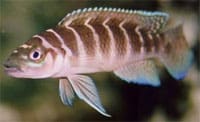
Common name: Cylindricus
Scientific name: Neolamprologus Cylindricus
Average Adult Fish Size: 12cm / 5 Inches
Place of Origin: Lake Tanganyika
Typical Tank setup: Rocky Tanganyika tank with shells.
Recommended Minimum Aquarium Capacity: 160 Litres
Compatibility: Neolamprologus species, altolamprologus, shoaling cyprichromis
Temperature: 23-28 Deg C / 73-82 Deg F
Water chemistry: pH 7.6-8.6
Feeding: Omnivorous – does well with flake or pellet foods. Suppliment with krill, brine shrimp and fresh vegetables such as peas, spinach, zucchini and romaine lettuce.
Sexing: Sexing by appearance is difficult because males and females look identical. Males are sometimes larger than females.
Breeding: To obtain a compatible breeding pair, it is recommended that a group of several juveniles are raised, and the ‘surplus’ fish removed once a pair has formed, to avoid serious aggression from the established pair. Spawning takes place in caves, which should have smooth walls to facilitate egg-laying. The female will protect the fry for a while after they emerge from the cave.
Additional Information: First and foremost, N. cylindricus is a rock-dwelling, substrate spawner. Both in the wild and Neolamprologus cylindricusin the tank, cylindricus stay very close to the rocks. Mine rarely ever stray more than a few inches from their caves, in contrast to the leleupi who are always out and about, but then use the caves to spawn. Cylindricus are always swimming in and out of my holey rock, and are usually found swimming on their sides or upside down, always hugging the rocks, which undoubtedly give them a sense of security. The adult male pictured to the left here, is usually found camped out in this little cave he’s claimed. I said that N. cylindricus is a substrate spawner, but it should really be called a cave spawner because this lamprologine will only lay its eggs in a cave. If no cave is provided, then it probably won’t spawn. Spawning takes place in the female’s cave. Eggs, numbering as many as 250, are laid on the walls of the cave, after which the male swims over them, depositing his milt. Larvae will hatch after 10 days or so and will begin to venture from the cave a week or so thereafter. The mother will protect the young for a few weeks and consequently, the parents may be left in the tank with the young. In the wild, Neolamprologus cylindricus is a predator, feeding on zoobenthic organisms, aquatic insects, copepods, and whatever else they can find in and between the rocks. In the aquarium, however, they readily accept flake and pellet foods. A quality Spirulina-based flake food is highly recommended. Other recommended foods include white and black mosquito larvae, plankton, and the European Shrimp Mix. Cylindricus can be successfully kept in a planted tank as they won’t touch even the tender shoots of new leaves. Anubias and Vallisneria species are both plant genera that do well in hard, alkaline water and don’t require lots of light. There are several color morphs. All varieties have the ten dark, varetical bars from the lips to the peduncle. Cylindricus from the north, however, tend to have lighter stripes (brownish-black) while those populations from the south have broader and significantly darker stripes (all black). There is a gold-head morph, whose young display a yellowish color around the head, but this is lost as the fish matures and there is yet another variety that has blue on the tips of its fins and just under its eye.


Related Posts
Croaking Gourami – Trichopsis vittatus
Benthochromis Tricoti
Large-eyed Mouthbrooder – Callochromis Macrops